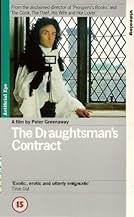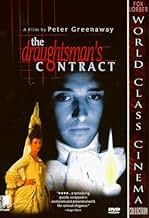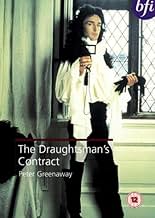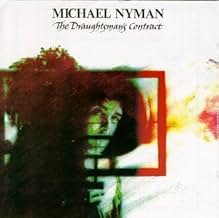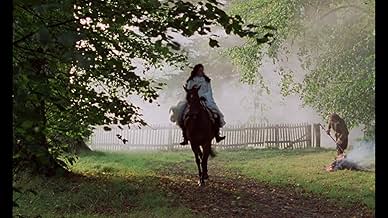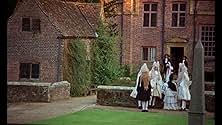IMDb RATING
7.2/10
12K
YOUR RATING
A young artist is commissioned by the wife of a wealthy landowner to make a series of drawings of the estate while her husband is away.A young artist is commissioned by the wife of a wealthy landowner to make a series of drawings of the estate while her husband is away.A young artist is commissioned by the wife of a wealthy landowner to make a series of drawings of the estate while her husband is away.
- Awards
- 1 win & 4 nominations total
Anne-Louise Lambert
- Mrs. Talmann
- (as Anne Louise Lambert)
Nicholas Amer
- Mr. Parkes
- (as Nicolas Amer)
Lynda La Plante
- Mrs. Clement
- (as Lynda Marchal)
Alastair G. Cumming
- Philip - Mr. Neville's assistant
- (as Alastair Cummings)
- Director
- Writer
- All cast & crew
- Production, box office & more at IMDbPro
Featured reviews
Being of English origin the film has a particular fascination. Certain things become apparent if you know England well, but also I suspect on repeated viewing.
A tale of conceit, deception and power. The conceit of the Draughtsman, all too apparent, is matched by the conceit of the upper classes as the film unfolds. The pictoral conceit referred to in the film repeatedly is matched by a pictoral conceit played on the viewer: the wigs were never that big, the house, garden and grounds stunning and the weather too perfect.
Deception exists at many levels. The viewer is deceived as to where the houses and events take place. The allusions are to Southampton and surrounding areas. Being from the Southampton area I realized this wasn't Southampton. Though it could possibly have been. The deception was convincing. The location is Kent. I believe this deception, which fits so nicely in the film anyway, was pulled so that the owner of the house where the film is centred around would not be invaded by tourists. A nice touch which I suspect follows the line in the film, something like this), "Do you think Mrs Talbot is a lady who likes her gravel being kicked around by a pack of dogs."
The arrogance and exploitation of the ladies of the house by the Draughtsman, readily apparent, is more sinisterly exceeded by the arrogance and exploitation of the Draughtsman by the ladies. The Draughtsman provides a cover for murder, solves the problem of transfer of the property by siring a child and finally ends up as the scapegoat for murder. While the Draughtsman may appear to be playing with the household for his own amusement, the Draughtsman himself is the focus of a much more brutal and more deadly game.
Like all the best films there is much going on in the film. The lines and language are wonderfully rich. The camera merely shows you the events. And it is not above deceiving you as a viewer. Trying to make sense of it all is great fun. Many things I didn't even see until the second or third viewing, let alone make sense of them!
A beautiful allegory which slowly unfolds and challenges the senses. Much like The Prisoner (1967) tv series, and hopefully The Prisoner (2000) movie.
A tale of conceit, deception and power. The conceit of the Draughtsman, all too apparent, is matched by the conceit of the upper classes as the film unfolds. The pictoral conceit referred to in the film repeatedly is matched by a pictoral conceit played on the viewer: the wigs were never that big, the house, garden and grounds stunning and the weather too perfect.
Deception exists at many levels. The viewer is deceived as to where the houses and events take place. The allusions are to Southampton and surrounding areas. Being from the Southampton area I realized this wasn't Southampton. Though it could possibly have been. The deception was convincing. The location is Kent. I believe this deception, which fits so nicely in the film anyway, was pulled so that the owner of the house where the film is centred around would not be invaded by tourists. A nice touch which I suspect follows the line in the film, something like this), "Do you think Mrs Talbot is a lady who likes her gravel being kicked around by a pack of dogs."
The arrogance and exploitation of the ladies of the house by the Draughtsman, readily apparent, is more sinisterly exceeded by the arrogance and exploitation of the Draughtsman by the ladies. The Draughtsman provides a cover for murder, solves the problem of transfer of the property by siring a child and finally ends up as the scapegoat for murder. While the Draughtsman may appear to be playing with the household for his own amusement, the Draughtsman himself is the focus of a much more brutal and more deadly game.
Like all the best films there is much going on in the film. The lines and language are wonderfully rich. The camera merely shows you the events. And it is not above deceiving you as a viewer. Trying to make sense of it all is great fun. Many things I didn't even see until the second or third viewing, let alone make sense of them!
A beautiful allegory which slowly unfolds and challenges the senses. Much like The Prisoner (1967) tv series, and hopefully The Prisoner (2000) movie.
Hugely enjoyable, if somewhat a tad too clever for its own good. A very good English director's attempt to be more continental, by being deliberately obscure, and throwing in large dollops of raunchy eroticism. Imagine if you will an episode of PBS's Mystery set during the Restoration, with a script by Einstein, and direction by Frederico Fellini.
Two excellent stage actors - Anthony Higgins and Janet Suzman - in combination with the very sultry and seldom seen Australian actress Anne Louise Lambert, act their sexy sox off in this delightful delicate pastry of a movie. In the year 1694 an artist is commissioned to create a series of precise drawings of an enormous country house. The twist is that his agreed form of payment is most unusual.
Michael Nyman's score is a careful, yet loud, modern arrangement with contemporary wind and string instruments. The photography by Curtis Clark is incredible, and these two creative artists convince you, you are in the 17th Century. The interior scenes are lit only by candlelight - as was also the case in Kubrick's superb historical masterpiece Barry Lyndon. This movie somehow combines elements of sophisticated themes of woman's self-empowerment, the inhumanity of the aristocracy, mathematics, and Benny Hill eroticism. Really rather wonderful and unique, but also in-retrospect, less than the sum of its parts. For a superior Peter Greenaway picture, try Drowning By Numbers, A Zed and Two Naughts, and The Cook, the Wife, etc..
Two excellent stage actors - Anthony Higgins and Janet Suzman - in combination with the very sultry and seldom seen Australian actress Anne Louise Lambert, act their sexy sox off in this delightful delicate pastry of a movie. In the year 1694 an artist is commissioned to create a series of precise drawings of an enormous country house. The twist is that his agreed form of payment is most unusual.
Michael Nyman's score is a careful, yet loud, modern arrangement with contemporary wind and string instruments. The photography by Curtis Clark is incredible, and these two creative artists convince you, you are in the 17th Century. The interior scenes are lit only by candlelight - as was also the case in Kubrick's superb historical masterpiece Barry Lyndon. This movie somehow combines elements of sophisticated themes of woman's self-empowerment, the inhumanity of the aristocracy, mathematics, and Benny Hill eroticism. Really rather wonderful and unique, but also in-retrospect, less than the sum of its parts. For a superior Peter Greenaway picture, try Drowning By Numbers, A Zed and Two Naughts, and The Cook, the Wife, etc..
Is Greenaway our most intelligent filmmaker? One of them at least. He is master of lush self-referential allegory. Here this is hung on a mystery masquerading as restoration comedy. Just maintaining the period and manner is quite a feat.
Self-reference. The film is about an artist who creates rich images that include incongruous elements. The arrogance of the artist is balanced by his blindness as to the meaning, the context of what the images reveal. Both the artist and the viewers are confused by the meaning and flummoxed by the events that the meaning triggers. Greenaway clearly means this to extend to himself, his film and the incompleteness of what we the viewers see. The drawings and the drawer's hands are in fact his.
Fantasy-allegory. This is a film richer in symbology than Drowning and Cook, but probably less so than the later `book' movies. Great attention has been spent on recondite supplementary images, including a central painting in the house being itself painted by the draftsman and filmmaker. I viewed it (the whole film) once just for details. The living statue is only the most obvious illogical element, and in fact draws attention away from other smaller visual diversions.
Mystery artifice. The whole environment is one of genteel artifice, hiding cruel mechanics of conspiracy. The cleverness of the construction is that Greenaway and us are full conspirators. No one, not us, him or the characters shown fully understand what is going on. The mystery form has always been a dialog between artist and consumer, a contest to see who can outwit whom. Very clever use of the mystery form here to include us in the artifice by not ever `playing fair.'
Restoration comedy. Past the visual allegory and the fantasy mystery and the self-reference is a restoration comedy which taken straight is hilarious. The statue is from this form.
My only criticisms are minor. This film contains a restrained story, and incidentally all sex takes place offscreen. Why be so conservative in these areas? Also, Lady Herbert required a more powerful actress I think.
Self-reference. The film is about an artist who creates rich images that include incongruous elements. The arrogance of the artist is balanced by his blindness as to the meaning, the context of what the images reveal. Both the artist and the viewers are confused by the meaning and flummoxed by the events that the meaning triggers. Greenaway clearly means this to extend to himself, his film and the incompleteness of what we the viewers see. The drawings and the drawer's hands are in fact his.
Fantasy-allegory. This is a film richer in symbology than Drowning and Cook, but probably less so than the later `book' movies. Great attention has been spent on recondite supplementary images, including a central painting in the house being itself painted by the draftsman and filmmaker. I viewed it (the whole film) once just for details. The living statue is only the most obvious illogical element, and in fact draws attention away from other smaller visual diversions.
Mystery artifice. The whole environment is one of genteel artifice, hiding cruel mechanics of conspiracy. The cleverness of the construction is that Greenaway and us are full conspirators. No one, not us, him or the characters shown fully understand what is going on. The mystery form has always been a dialog between artist and consumer, a contest to see who can outwit whom. Very clever use of the mystery form here to include us in the artifice by not ever `playing fair.'
Restoration comedy. Past the visual allegory and the fantasy mystery and the self-reference is a restoration comedy which taken straight is hilarious. The statue is from this form.
My only criticisms are minor. This film contains a restrained story, and incidentally all sex takes place offscreen. Why be so conservative in these areas? Also, Lady Herbert required a more powerful actress I think.
A most extraordinary film. A fascinating study of manipulation and murder, of sex, power and the abuse of sex and power. This is not always an easy film to like, it has a coldly clinical approach to its subject and protagonists which produces an intentionally distancing effect.
In one scene, the Draughtsman invites the Lady of the House to examine a painting, owned by her husband, in which a complex allegory appears to be being acted out. I see this as an analogy for the film as a whole - it is an arch, stylised, intelligent and beautiful puzzle (a murder-mystery) in which the audience is encouraged to consider the motives and objectives of the characters, but from which many important clues appear to have been deliberately removed.
This might all sound frustrating, but I find the film endlessly intriguing and entertaining. It's like a very clever and stunningly photographed Agatha Christie mystery, but without an annoying sleuth who comes along at the end and solves everything "oh-so-neatly".
The photography is exemplary (the cinematographer, Curtis Clark, seems to have done little else of note), with the camera hardly moving at all, except for an occasional tracking shot. The Kent countryside used to maximum effect, and the costumes are sumptuous (especially the wigs!). The music is also superb, with Michael Nyman producing probably his finest score.
An engaging, puzzling, visually stunning and, ultimately, rather disturbing film.
In one scene, the Draughtsman invites the Lady of the House to examine a painting, owned by her husband, in which a complex allegory appears to be being acted out. I see this as an analogy for the film as a whole - it is an arch, stylised, intelligent and beautiful puzzle (a murder-mystery) in which the audience is encouraged to consider the motives and objectives of the characters, but from which many important clues appear to have been deliberately removed.
This might all sound frustrating, but I find the film endlessly intriguing and entertaining. It's like a very clever and stunningly photographed Agatha Christie mystery, but without an annoying sleuth who comes along at the end and solves everything "oh-so-neatly".
The photography is exemplary (the cinematographer, Curtis Clark, seems to have done little else of note), with the camera hardly moving at all, except for an occasional tracking shot. The Kent countryside used to maximum effect, and the costumes are sumptuous (especially the wigs!). The music is also superb, with Michael Nyman producing probably his finest score.
An engaging, puzzling, visually stunning and, ultimately, rather disturbing film.
The first Peter Greenaway's feature "The Draughtsman's Contract" (1982) - is absolutely delightful, devilishly clever (just imagine the best Agatha Christy's mystery with all sorts of clues and suspects but without Poirot or Ms. Maple to explain in the end whodunit and why. You are on your own to try to figure out - everything you need to know is right there), and funny (Yes, Greenaway can be funny!) art film - the perfect example of an art film. It combines the elements of social satire with murder mystery, meditates on the power of art and role of an artist, studies family drama and mothers -daughters love and understanding, perfectly wraps it in sensual pleasure - and what the pleasure it is. I know I will watch it again because it is a feast for eyes (I've seen big budget movies that looked plain comparing to this one shot on the limited funds), ears (Michael Nyman wrote one of the best score ever for this film) and for brain - there are mysteries and puzzles in every frame and in every dialog.
There is couple of Greenaway's thoughts on his first film and on the films that influenced him from the interview that was published in L'Avant-Scene Cinema", No 333, October 1984:
"Majority of my films may be viewed on several levels. Thus, in "The Draughtsman's Contract" there was the desire to open the symbolism of plants and fruits, to study the connections between the aristocrats and the common people, the conflicts between the worlds of gentlemen and of servants. With my films, I hope to generate interest, to stimulate imagination, to wake feelings...
I consider that 90% of my films one way or another refers to paintings. "Contract" quite openly refers to Caravaggio, Georges de la Tour and other French and Italian artists...
Before the work on the film began, I did not explain to film crew what I wanted, but I showed them five European films: "Fellini's Casanova", "The Last Tango in Paris" by Bertolucci, "The Marquise of O" by Eric Rohmer, "Chronicle of Anna Magdalena Bach" by Jean-Marie Straub and, most importantly, "Last Year at Marienbad" by Alain Resnais which has been the most influential film for me."
There is couple of Greenaway's thoughts on his first film and on the films that influenced him from the interview that was published in L'Avant-Scene Cinema", No 333, October 1984:
"Majority of my films may be viewed on several levels. Thus, in "The Draughtsman's Contract" there was the desire to open the symbolism of plants and fruits, to study the connections between the aristocrats and the common people, the conflicts between the worlds of gentlemen and of servants. With my films, I hope to generate interest, to stimulate imagination, to wake feelings...
I consider that 90% of my films one way or another refers to paintings. "Contract" quite openly refers to Caravaggio, Georges de la Tour and other French and Italian artists...
Before the work on the film began, I did not explain to film crew what I wanted, but I showed them five European films: "Fellini's Casanova", "The Last Tango in Paris" by Bertolucci, "The Marquise of O" by Eric Rohmer, "Chronicle of Anna Magdalena Bach" by Jean-Marie Straub and, most importantly, "Last Year at Marienbad" by Alain Resnais which has been the most influential film for me."
Did you know
- TriviaDirector Peter Greenaway, a former art student, created the sketches that feature in the film. In fact the close-up shots of the draughtsman drawing are of his hands.
- GoofsThe cooing of a collared dove is not a sound that would have fallen on Jacobean ears, as the species was unknown in Britain until 1955.
- Quotes
Mr. Neville: You must forgive my curiosity, madam, and open your knees.
- Alternate versionsWhen Peter Greenaway screened the movie at festivals in 1982, it ran a full three hours. Included in this footage is a full and further explained rationale for the moving statue.
- How long is The Draughtsman's Contract?Powered by Alexa
Details
- Release date
- Country of origin
- Languages
- Also known as
- The Draughtsman's Contract
- Filming locations
- Groombridge Place, Groombridge, Kent, England, UK(country house)
- Production companies
- See more company credits at IMDbPro
Box office
- Budget
- £320,000 (estimated)
- Gross US & Canada
- $2,256,246
- Gross worldwide
- $2,283,233
Contribute to this page
Suggest an edit or add missing content




